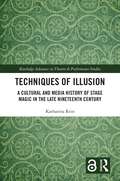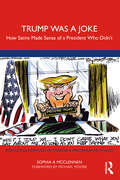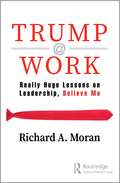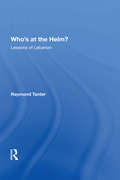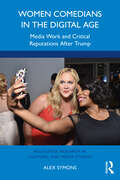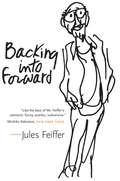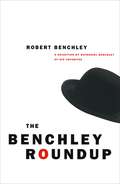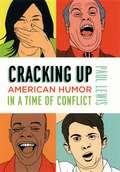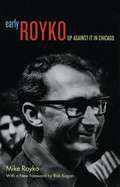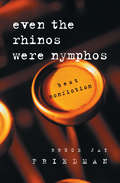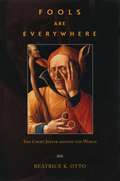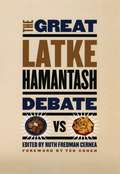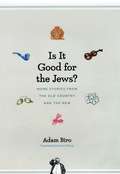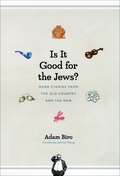- Table View
- List View
Techniques of Illusion: A Cultural and Media History of Stage Magic in the Late Nineteenth Century (Routledge Advances in Theatre & Performance Studies)
by Katharina ReinThis book explores stage conjuring during its “golden age,” from about 1860 to 1910. This study provides close readings highlighting four paradigmatic illusions of the time that stand in for different kinds of illusions typical of stage magic in the “golden age” and analyses them within their cultural and media-historical context: “Pepper’s Ghost,” the archetypical mirror illusion; “The Vanishing Lady,” staging a teleportation in a time of a dizzying acceleration of transport; “the levitation,” simulating weightlessness with the help of an extended steel machinery; and “The Second Sight,” a mind-reading illusion using up-to-date communication technologies. These close readings are completed by writings focusing on visual media and expanding the scope backwards and forwards in time, roughly to 1800 and to 2000. This exploration will be of great interest to students and scholars in theatre and performance studies.
Techniques of Illusion: A Cultural and Media History of Stage Magic in the Late Nineteenth Century (Routledge Advances in Theatre & Performance Studies)
by Katharina ReinThis book explores stage conjuring during its “golden age,” from about 1860 to 1910. This study provides close readings highlighting four paradigmatic illusions of the time that stand in for different kinds of illusions typical of stage magic in the “golden age” and analyses them within their cultural and media-historical context: “Pepper’s Ghost,” the archetypical mirror illusion; “The Vanishing Lady,” staging a teleportation in a time of a dizzying acceleration of transport; “the levitation,” simulating weightlessness with the help of an extended steel machinery; and “The Second Sight,” a mind-reading illusion using up-to-date communication technologies. These close readings are completed by writings focusing on visual media and expanding the scope backwards and forwards in time, roughly to 1800 and to 2000. This exploration will be of great interest to students and scholars in theatre and performance studies.
Trump Was a Joke: How Satire Made Sense of a President Who Didn’t (Routledge Advances in Theatre & Performance Studies)
by Sophia A McclennenWritten by a scholar of satire and politics, Trump Was a Joke explains why satire is an exceptional foil for absurd political times and why it did a particularly good job of making sense of Trump. Covering a range of comedic interventions, Trump Was a Joke analyzes why political satire is surprisingly effective at keeping us sane when politics is making us crazy. Its goal is to highlight the unique power of political satire to encourage critical thinking, foster civic action, and further rational debate in moments of political hubris and hysteria. The book has been endorsed by Bassem Youssef, who has been referred to as the “Jon Stewart of Egypt,” and Srdja Popovic, author of Blueprint for Revolution, who used satirical activism to bring down Serbian dictator Slobodan Milosevic. With a foreword by award-winning filmmaker, satirist, and activist Michael Moore, this study will be of interest to readers who follow politics and enjoy political comedy and will appeal to the communications, comedy studies, media studies, political science, rhetoric, cultural studies, and American studies markets.
Trump Was a Joke: How Satire Made Sense of a President Who Didn’t (Routledge Advances in Theatre & Performance Studies)
by Sophia A McclennenWritten by a scholar of satire and politics, Trump Was a Joke explains why satire is an exceptional foil for absurd political times and why it did a particularly good job of making sense of Trump. Covering a range of comedic interventions, Trump Was a Joke analyzes why political satire is surprisingly effective at keeping us sane when politics is making us crazy. Its goal is to highlight the unique power of political satire to encourage critical thinking, foster civic action, and further rational debate in moments of political hubris and hysteria. The book has been endorsed by Bassem Youssef, who has been referred to as the “Jon Stewart of Egypt,” and Srdja Popovic, author of Blueprint for Revolution, who used satirical activism to bring down Serbian dictator Slobodan Milosevic. With a foreword by award-winning filmmaker, satirist, and activist Michael Moore, this study will be of interest to readers who follow politics and enjoy political comedy and will appeal to the communications, comedy studies, media studies, political science, rhetoric, cultural studies, and American studies markets.
Trump @ Work: Really Huge Lessons on Leadership, Believe Me
by Richard A. Moran"Unprecedented" is the adjective most often ascribed to everything about Donald Trump. Trump @ Work is about the unprecedented impact that Donald Trump and his Presidency and style has had on attitudes and perceptions of leadership and management. This book brings a unique perspective about what has changed and what has not changed through humorous and true "bullets" and observations. Why do some leaders get fired for things that other leaders boast about? In spite of controversy, why do some initiatives still get implemented? Is implementation all that matters? Is empathy and credibility still critical to success? Why aren’t there any instruction manuals about how to navigate the new workplace? These are not questions raised by just a few. These are questions everyone in the workplace is asking. Trump @ Work explores these questions and many more. It reveals how the rules of the game have changed for everyone seeking success or at least, to survive. It’s hard enough to keep up with leadership and management trends. Donald Trump is making it more difficult, not intentionally, not through the tweets he writes, but by how he is challenging the long existing norms. Who knew that tweeting would become an established way of communicating to an organization? Who knew that in spite of constant searing criticism, one can disregard it and continue to follow an agenda? Who knew that preaching to supporters and ignoring naysayers is a way to manage? Whether you appreciate Donald Trump or not, he has had an impact on the thinking about leadership and management and the author precisely explores that impact in this book.
Trump @ Work: Really Huge Lessons on Leadership, Believe Me
by Richard A. Moran"Unprecedented" is the adjective most often ascribed to everything about Donald Trump. Trump @ Work is about the unprecedented impact that Donald Trump and his Presidency and style has had on attitudes and perceptions of leadership and management. This book brings a unique perspective about what has changed and what has not changed through humorous and true "bullets" and observations. Why do some leaders get fired for things that other leaders boast about? In spite of controversy, why do some initiatives still get implemented? Is implementation all that matters? Is empathy and credibility still critical to success? Why aren’t there any instruction manuals about how to navigate the new workplace? These are not questions raised by just a few. These are questions everyone in the workplace is asking. Trump @ Work explores these questions and many more. It reveals how the rules of the game have changed for everyone seeking success or at least, to survive. It’s hard enough to keep up with leadership and management trends. Donald Trump is making it more difficult, not intentionally, not through the tweets he writes, but by how he is challenging the long existing norms. Who knew that tweeting would become an established way of communicating to an organization? Who knew that in spite of constant searing criticism, one can disregard it and continue to follow an agenda? Who knew that preaching to supporters and ignoring naysayers is a way to manage? Whether you appreciate Donald Trump or not, he has had an impact on the thinking about leadership and management and the author precisely explores that impact in this book.
Who's At The Helm?: Lessons Of Lebanon
by Raymond TanterThe author underlines what he considers to be the "lessons of Lebanon" for US foreign policy in the greater Middle East and in the world at large. He suggests that the President must take the lead in policy formulation and interagency coordination; diplomacy and force must both be a part of balanced foreign policy; and "loose cannons" like Robert
Who's At The Helm?: Lessons Of Lebanon
by Raymond TanterThe author underlines what he considers to be the "lessons of Lebanon" for US foreign policy in the greater Middle East and in the world at large. He suggests that the President must take the lead in policy formulation and interagency coordination; diplomacy and force must both be a part of balanced foreign policy; and "loose cannons" like Robert
Women Comedians in the Digital Age: Media Work and Critical Reputations After Trump (Routledge Research in Cultural and Media Studies)
by Alex SymonsThis book offers a thorough examination of digital work by women comedians in the US, exploring their use of digital media to perform jokes, engage with fans, remake their reputations, and become political activists. This book argues that despite its many adverse effects, digital work is changing comedy, empowering women to create new comic forms and negotiate the contentious political climate incited by former President Donald. J. Trump. Chapters are focused on video podcasting, TikTok, Twitter, Instagram, YouTube, and the streaming platform Netflix – each containing informative case studies on significant women comedians who use them, including Sarah Silverman, Amy Schumer, Leslie Jones, Mindy Kaling, Colleen Ballinger, Lilly Singh, Ms. Pat, Whitney Cummings, Issa Rae, and others. To understand their strategies, this book examines the popularity of their digital content, their career outcomes in television and film, as well as the ups and downs of their critical reputations in magazines, newspapers, the trade press, and with their participatory audiences online. This insightful and timely work will appeal to scholars researching and teaching in the areas of media studies, digital communication, gender studies, and performance.
Women Comedians in the Digital Age: Media Work and Critical Reputations After Trump (Routledge Research in Cultural and Media Studies)
by Alex SymonsThis book offers a thorough examination of digital work by women comedians in the US, exploring their use of digital media to perform jokes, engage with fans, remake their reputations, and become political activists. This book argues that despite its many adverse effects, digital work is changing comedy, empowering women to create new comic forms and negotiate the contentious political climate incited by former President Donald. J. Trump. Chapters are focused on video podcasting, TikTok, Twitter, Instagram, YouTube, and the streaming platform Netflix – each containing informative case studies on significant women comedians who use them, including Sarah Silverman, Amy Schumer, Leslie Jones, Mindy Kaling, Colleen Ballinger, Lilly Singh, Ms. Pat, Whitney Cummings, Issa Rae, and others. To understand their strategies, this book examines the popularity of their digital content, their career outcomes in television and film, as well as the ups and downs of their critical reputations in magazines, newspapers, the trade press, and with their participatory audiences online. This insightful and timely work will appeal to scholars researching and teaching in the areas of media studies, digital communication, gender studies, and performance.
Backing into Forward: A Memoir
by Jules FeifferSubversive, funny, and effortlessly droll, Jules Feiffer’s cartoons were all over New York in the 1960s and ’70s—featured in the Village Voice, but also cut out and pinned to bulletin boards in offices and on refrigerators at home. Feiffer describes himself as “lucking into the zeitgeist,” and there’s some truth to the sentiment; Feiffer’s brand of satire reflected Americans’ ambivalence about the Vietnam War, changing social mores, and much more. Feiffer’s memoir, Backing into Forward, like his cartoons, is sharply perceptive with a distinctive bite of mordant humor. Beginning with his childhood in Brooklyn, Feiffer paints a picture of a troubled kid with an overbearing mother and a host of crippling anxieties. From there, he discusses his apprenticeship with his hero, Will Eisner, and his time serving in the military during the Korean War, which saw him both feigning a breakdown and penning a cartoon narrative called “Munro” that solidified his distinctive aesthetic as an artist. While Feiffer’s voice grounds the book, the sheer scope of his artistic accomplishment, from his cartoons turning up in the New Yorker, Playboy, and the Nation to his plays and film scripts, is remarkable and keeps the narrative bouncing along at a speedy clip. A compelling combination of a natural sense of humor and a ruthless dedication to authenticity, Backing into Forward is full of wit and verve, often moving but never sentimental. “Jules Feiffer’s original and neurotic voice. . . . reinvented comics in the 1950s and made possible what’s now called the ‘graphic novel.’ His engaging new memoir is told in that same witty and perceptive New York cadence, mellowed and laced with wisdom. He’s an inspiration.”—Art Spiegelman
The Benchley Roundup: A Selection by Nathaniel Benchley of his Favorites
by Robert C. BenchleyRobert C. Benchley's sketches and articles, published in periodicals like Life, Vanity Fair, and The New Yorker, earned him a reputation as one of the sharpest humorists of his time; his influence—on contemporaries such as E. B. White, James Thurber, and S. J. Perelman, or followers like Woody Allen, Steve Martin, and Richard Pryor—has left an indelible mark on the American comic tradition. The Benchley Roundup collects those pieces, selected by Benchley's son Nathaniel, "which seem to stand up best over the years"-a compendium of the most endearing and enduring work from one of America's funniest and most penetrating wits. "It took me fifteen years to discover that I had no talent for writing, but I couldn't give it up because by then I was too famous." —Robert Benchley
Cracking Up: American Humor in a Time of Conflict
by Paul LewisWhat do Jon Stewart, Freddy Krueger, Patch Adams, and George W. Bush have in common? As Paul Lewis shows in Cracking Up, they are all among the ranks of joke tellers who aim to do much more than simply amuse. Exploring topics that range from the sadistic mockery of Abu Ghraib prison guards to New Age platitudes about the healing power of laughter, from jokes used to ridicule the possibility of global climate change to the heartwarming performances of hospital clowns, Lewis demonstrates that over the past thirty years American humor has become increasingly purposeful and embattled. Navigating this contentious world of controversial, manipulative, and disturbing laughter, Cracking Up argues that the good news about American humor in our time—that it is delightful, relaxing, and distracting—is also the bad news. In a culture that both enjoys and quarrels about jokes, humor expresses our most nurturing and hurtful impulses, informs and misinforms us, and exposes as well as covers up the shortcomings of our leaders. Wondering what’s so funny about a culture determined to laugh at problems it prefers not to face, Lewis reveals connections between such seemingly unrelated jokers as Norman Cousins, Hannibal Lecter, Rush Limbaugh, Garry Trudeau, Jay Leno, Ronald Reagan, Beavis and Butt-Head, and Bill Clinton. The result is a surprising, alarming, and at times hilarious argument that will appeal to anyone interested in the ways humor is changing our cultural and political landscapes.
Early Royko: Up Against It in Chicago
by Mike RoykoCombining the incisive pen of a newspaperman and the compassionate soul of a poet, Mike Royko became a Chicago institution—in Jimmy Breslin’s words, "the best journalist of his time." Early Royko: Up Against It in Chicago will restore to print the legendary columnist’s earliest writings, which chronicle 1960s Chicago with the moral vision, ironic sense, and razor-sharp voice that would remain Royko’s trademark. This collection of early columns from the Chicago Daily News ranges from witty social commentary to politically astute satire. Some of the pieces are falling-down funny and others are tenderly nostalgic, but all display Royko’s unrivaled skill at using humor to tell truth to power. From machine politicians and gangsters to professional athletes, from well-heeled Chicagoans to down-and-out hoodlums, no one escapes Royko’s penetrating gaze—and resounding judgment. Early Royko features a memorable collection of characters, including such well-known figures as Hugh Hefner, Mayor Richard J. Daley, and Dr. Martin Luther King. But these boldfaced names are juxtaposed with Royko’s beloved lesser knowns from the streets of Chicago: Mrs. Peak, Sylvester "Two-Gun Pete" Washington, and Fats Boylermaker, who gained fame for leaning against a corner light pole from 2 a.m. Saturday until noon Sunday, when his neighborhood tavern reopened for business. Accompanied by a foreword from Rick Kogan, this new edition will delight Royko’s most ardent fans and capture the hearts of a new generation of readers. As Kogan writes, Early Royko "will remind us how a remarkable relationship began—Chicago and Royko, Royko and Chicago—and how it endures."
Early Royko: Up Against It in Chicago
by Mike RoykoCombining the incisive pen of a newspaperman and the compassionate soul of a poet, Mike Royko became a Chicago institution—in Jimmy Breslin’s words, "the best journalist of his time." Early Royko: Up Against It in Chicago will restore to print the legendary columnist’s earliest writings, which chronicle 1960s Chicago with the moral vision, ironic sense, and razor-sharp voice that would remain Royko’s trademark. This collection of early columns from the Chicago Daily News ranges from witty social commentary to politically astute satire. Some of the pieces are falling-down funny and others are tenderly nostalgic, but all display Royko’s unrivaled skill at using humor to tell truth to power. From machine politicians and gangsters to professional athletes, from well-heeled Chicagoans to down-and-out hoodlums, no one escapes Royko’s penetrating gaze—and resounding judgment. Early Royko features a memorable collection of characters, including such well-known figures as Hugh Hefner, Mayor Richard J. Daley, and Dr. Martin Luther King. But these boldfaced names are juxtaposed with Royko’s beloved lesser knowns from the streets of Chicago: Mrs. Peak, Sylvester "Two-Gun Pete" Washington, and Fats Boylermaker, who gained fame for leaning against a corner light pole from 2 a.m. Saturday until noon Sunday, when his neighborhood tavern reopened for business. Accompanied by a foreword from Rick Kogan, this new edition will delight Royko’s most ardent fans and capture the hearts of a new generation of readers. As Kogan writes, Early Royko "will remind us how a remarkable relationship began—Chicago and Royko, Royko and Chicago—and how it endures."
Early Royko: Up Against It in Chicago
by Mike RoykoCombining the incisive pen of a newspaperman and the compassionate soul of a poet, Mike Royko became a Chicago institution—in Jimmy Breslin’s words, "the best journalist of his time." Early Royko: Up Against It in Chicago will restore to print the legendary columnist’s earliest writings, which chronicle 1960s Chicago with the moral vision, ironic sense, and razor-sharp voice that would remain Royko’s trademark. This collection of early columns from the Chicago Daily News ranges from witty social commentary to politically astute satire. Some of the pieces are falling-down funny and others are tenderly nostalgic, but all display Royko’s unrivaled skill at using humor to tell truth to power. From machine politicians and gangsters to professional athletes, from well-heeled Chicagoans to down-and-out hoodlums, no one escapes Royko’s penetrating gaze—and resounding judgment. Early Royko features a memorable collection of characters, including such well-known figures as Hugh Hefner, Mayor Richard J. Daley, and Dr. Martin Luther King. But these boldfaced names are juxtaposed with Royko’s beloved lesser knowns from the streets of Chicago: Mrs. Peak, Sylvester "Two-Gun Pete" Washington, and Fats Boylermaker, who gained fame for leaning against a corner light pole from 2 a.m. Saturday until noon Sunday, when his neighborhood tavern reopened for business. Accompanied by a foreword from Rick Kogan, this new edition will delight Royko’s most ardent fans and capture the hearts of a new generation of readers. As Kogan writes, Early Royko "will remind us how a remarkable relationship began—Chicago and Royko, Royko and Chicago—and how it endures."
Early Royko: Up Against It in Chicago
by Mike RoykoCombining the incisive pen of a newspaperman and the compassionate soul of a poet, Mike Royko became a Chicago institution—in Jimmy Breslin’s words, "the best journalist of his time." Early Royko: Up Against It in Chicago will restore to print the legendary columnist’s earliest writings, which chronicle 1960s Chicago with the moral vision, ironic sense, and razor-sharp voice that would remain Royko’s trademark. This collection of early columns from the Chicago Daily News ranges from witty social commentary to politically astute satire. Some of the pieces are falling-down funny and others are tenderly nostalgic, but all display Royko’s unrivaled skill at using humor to tell truth to power. From machine politicians and gangsters to professional athletes, from well-heeled Chicagoans to down-and-out hoodlums, no one escapes Royko’s penetrating gaze—and resounding judgment. Early Royko features a memorable collection of characters, including such well-known figures as Hugh Hefner, Mayor Richard J. Daley, and Dr. Martin Luther King. But these boldfaced names are juxtaposed with Royko’s beloved lesser knowns from the streets of Chicago: Mrs. Peak, Sylvester "Two-Gun Pete" Washington, and Fats Boylermaker, who gained fame for leaning against a corner light pole from 2 a.m. Saturday until noon Sunday, when his neighborhood tavern reopened for business. Accompanied by a foreword from Rick Kogan, this new edition will delight Royko’s most ardent fans and capture the hearts of a new generation of readers. As Kogan writes, Early Royko "will remind us how a remarkable relationship began—Chicago and Royko, Royko and Chicago—and how it endures."
Even the Rhinos Were Nymphos: Best Nonfiction
by Bruce Jay FriedmanA few years ago, Christopher Buckley wrote of Bruce Jay Friedman in the New York Times Book Review that he "has been likened to everyone from J. D. Salinger to Woody Allen," but that "he is: Bruce Jay Friedman, sui generis, and no mean thing. No further comparisons are necessary." We are happy to report that he remains the same Bruce Jay Friedman in his unique, unblinking, and slightly tilted essays—collected here for the first time—in Even the Rhinos Were Nymphos. A butler school in Houston, a livestock auction in Little Rock, a home for "frozen guys" in California, JFK's humidor in Manhattan—all are jumping off points for Friedman's baleful and sharply satirical scrutiny of American life and behavior in the second half of the twentieth century. Travel with Friedman from Harlem to Hollywood, from Port-au-Prince to Etta's Eat Shop in Chicago. In these pieces, which were published in literary and mass-circulation magazines from the 1960s to the 1990s, you'll meet such luminaries as Castro and Clinton, Natalie Wood and Clint Eastwood, and even Friedman's friends Irwin Shaw, Nelson Algren, and Mario Puzo. Friedman is a master of the essay, whether the subject is crime reporting ("Lessons of the Street"), Hollywood shenanigans ("My Life among the Stars"), or his outrageous adventures as the editor of pulp magazines (the classic "Even the Rhinos Were Nymphos"). We could sing his praises as a journalist, humorist, and social critic. But, as Buckley tells us, being Bruce Jay Friedman is enough. Bruce Jay Friedman is the author of seven novels (including The Dick, Stern, and A Mother's Kisses), four collections of short stories, four full-length plays (including Scuba Duba and Steambath), and the screenplays for the movies Splash and Stir Crazy.
Even the Rhinos Were Nymphos: Best Nonfiction
by Bruce Jay FriedmanA few years ago, Christopher Buckley wrote of Bruce Jay Friedman in the New York Times Book Review that he "has been likened to everyone from J. D. Salinger to Woody Allen," but that "he is: Bruce Jay Friedman, sui generis, and no mean thing. No further comparisons are necessary." We are happy to report that he remains the same Bruce Jay Friedman in his unique, unblinking, and slightly tilted essays—collected here for the first time—in Even the Rhinos Were Nymphos. A butler school in Houston, a livestock auction in Little Rock, a home for "frozen guys" in California, JFK's humidor in Manhattan—all are jumping off points for Friedman's baleful and sharply satirical scrutiny of American life and behavior in the second half of the twentieth century. Travel with Friedman from Harlem to Hollywood, from Port-au-Prince to Etta's Eat Shop in Chicago. In these pieces, which were published in literary and mass-circulation magazines from the 1960s to the 1990s, you'll meet such luminaries as Castro and Clinton, Natalie Wood and Clint Eastwood, and even Friedman's friends Irwin Shaw, Nelson Algren, and Mario Puzo. Friedman is a master of the essay, whether the subject is crime reporting ("Lessons of the Street"), Hollywood shenanigans ("My Life among the Stars"), or his outrageous adventures as the editor of pulp magazines (the classic "Even the Rhinos Were Nymphos"). We could sing his praises as a journalist, humorist, and social critic. But, as Buckley tells us, being Bruce Jay Friedman is enough. Bruce Jay Friedman is the author of seven novels (including The Dick, Stern, and A Mother's Kisses), four collections of short stories, four full-length plays (including Scuba Duba and Steambath), and the screenplays for the movies Splash and Stir Crazy.
Even the Rhinos Were Nymphos: Best Nonfiction
by Bruce Jay FriedmanA few years ago, Christopher Buckley wrote of Bruce Jay Friedman in the New York Times Book Review that he "has been likened to everyone from J. D. Salinger to Woody Allen," but that "he is: Bruce Jay Friedman, sui generis, and no mean thing. No further comparisons are necessary." We are happy to report that he remains the same Bruce Jay Friedman in his unique, unblinking, and slightly tilted essays—collected here for the first time—in Even the Rhinos Were Nymphos. A butler school in Houston, a livestock auction in Little Rock, a home for "frozen guys" in California, JFK's humidor in Manhattan—all are jumping off points for Friedman's baleful and sharply satirical scrutiny of American life and behavior in the second half of the twentieth century. Travel with Friedman from Harlem to Hollywood, from Port-au-Prince to Etta's Eat Shop in Chicago. In these pieces, which were published in literary and mass-circulation magazines from the 1960s to the 1990s, you'll meet such luminaries as Castro and Clinton, Natalie Wood and Clint Eastwood, and even Friedman's friends Irwin Shaw, Nelson Algren, and Mario Puzo. Friedman is a master of the essay, whether the subject is crime reporting ("Lessons of the Street"), Hollywood shenanigans ("My Life among the Stars"), or his outrageous adventures as the editor of pulp magazines (the classic "Even the Rhinos Were Nymphos"). We could sing his praises as a journalist, humorist, and social critic. But, as Buckley tells us, being Bruce Jay Friedman is enough. Bruce Jay Friedman is the author of seven novels (including The Dick, Stern, and A Mother's Kisses), four collections of short stories, four full-length plays (including Scuba Duba and Steambath), and the screenplays for the movies Splash and Stir Crazy.
Even the Rhinos Were Nymphos: Best Nonfiction
by Bruce Jay FriedmanA few years ago, Christopher Buckley wrote of Bruce Jay Friedman in the New York Times Book Review that he "has been likened to everyone from J. D. Salinger to Woody Allen," but that "he is: Bruce Jay Friedman, sui generis, and no mean thing. No further comparisons are necessary." We are happy to report that he remains the same Bruce Jay Friedman in his unique, unblinking, and slightly tilted essays—collected here for the first time—in Even the Rhinos Were Nymphos. A butler school in Houston, a livestock auction in Little Rock, a home for "frozen guys" in California, JFK's humidor in Manhattan—all are jumping off points for Friedman's baleful and sharply satirical scrutiny of American life and behavior in the second half of the twentieth century. Travel with Friedman from Harlem to Hollywood, from Port-au-Prince to Etta's Eat Shop in Chicago. In these pieces, which were published in literary and mass-circulation magazines from the 1960s to the 1990s, you'll meet such luminaries as Castro and Clinton, Natalie Wood and Clint Eastwood, and even Friedman's friends Irwin Shaw, Nelson Algren, and Mario Puzo. Friedman is a master of the essay, whether the subject is crime reporting ("Lessons of the Street"), Hollywood shenanigans ("My Life among the Stars"), or his outrageous adventures as the editor of pulp magazines (the classic "Even the Rhinos Were Nymphos"). We could sing his praises as a journalist, humorist, and social critic. But, as Buckley tells us, being Bruce Jay Friedman is enough. Bruce Jay Friedman is the author of seven novels (including The Dick, Stern, and A Mother's Kisses), four collections of short stories, four full-length plays (including Scuba Duba and Steambath), and the screenplays for the movies Splash and Stir Crazy.
Fools Are Everywhere: The Court Jester Around the World
by Beatrice K. OttoIn this lively work, Beatrice K. Otto takes us on a journey around the world in search of one of the most colorful characters in history—the court jester. Though not always clad in cap and bells, these witty, quirky characters crop up everywhere, from the courts of ancient China and the Mogul emperors of India to those of medieval Europe, Africa, the Middle East, and the Americas. With a wealth of anecdotes, jokes, quotations, epigraphs, and illustrations (including flip art), Otto brings to light little-known jesters, highlighting their humanizing influence on people with power and position and placing otherwise remote historical figures in a more idiosyncratic, intimate light. Most of the work on the court jester has concentrated on Europe; Otto draws on previously untranslated classical Chinese writings and other sources to correct this bias and also looks at jesters in literature, mythology, and drama. Written with wit and humor, Fools Are Everywhere is the most comprehensive look at these roguish characters who risked their necks not only to mock and entertain but also to fulfill a deep and widespread human and social need.
The Great Latke-Hamantash Debate (The\other Voice In Early Modern Europe Ser.)
by Ruth Fredman Cernea Ted CohenCreation versus evolution. Nature versus nurture. Free will versus determinism. Every November at the University of Chicago, the best minds in the world consider the question that ranks with these as one of the most enduring of human history: latke or hamantash? This great latke-hamantash debate, occurring every year for the past six decades, brings Nobel laureates, university presidents, and notable scholars together to debate whether the potato pancake or the triangular Purim pastry is in fact the worthier food. What began as an informal gathering is now an institution that has been replicated on campuses nationwide. Highly absurd yet deeply serious, the annual debate is an opportunity for both ethnic celebration and academic farce. In poetry, essays, jokes, and revisionist histories, members of elite American academies attack the latke-versus-hamantash question with intellectual panache and an unerring sense of humor, if not chutzpah. The Great Latke-Hamantash Debate is the first collection of the best of these performances, from Martha Nussbaum's paean to both foods—in the style of Hecuba's Lament—to Nobel laureate Leon Lederman's proclamation on the union of the celebrated dyad. The latke and the hamantash are here revealed as playing a critical role in everything from Chinese history to the Renaissance, the works of Jane Austen to constitutional law. Philosopher and humorist Ted Cohen supplies a wry foreword, while anthropologist Ruth Fredman Cernea provides historical and social context as well as an overview of the Jewish holidays, latke and hamantash recipes, and a glossary of Yiddish and Hebrew terms, making the book accessible even to the uninitiated. The University of Chicago may have split the atom in 1942, but it's still working on the equally significant issue of the latke versus the hamantash. “As if we didn’t have enough on our plates, here’s something new to argue about. . . . To have to pick between sweet and savory, round and triangular, latke and hamantash. How to choose? . . . Thank goodness one of our great universities—Chicago, no less—is on the case. For more than 60 years, it has staged an annual latke-hamantash debate. . . . So, is this book funny? Of course it’s funny, even laugh-out-loud funny. It’s Mickey Katz in academic drag, Borscht Belt with a PhD.”—David Kaufmann, Forward
Is It Good for the Jews?: More Stories from the Old Country and the New
by Adam Biro“Jewish stories,” writes Adam Biro, “resemble every people’s stories.” Yet at the same time there is no better way to understand the soul, history, millennial suffering, or, crucially, the joys of the Jewish people than through such tales—“There’s nothing,” writes Biro, “more revelatory of the Jewish being.” With Is It Good for the Jews? Biro offers a sequel to his acclaimed collection of stories Two Jews on a Train. Through twenty-nine tales—some new, some old, but all finely wrought and rich in humor—Biro spins stories of characters coping with the vicissitudes and reverses of daily life, while simultaneously painting a poignant portrait of a world of unassimilated Jewish life that has largely been lost to the years. From rabbis competing to see who is the most humble, to the father who uses suicide threats to pressure his children into visiting, to three men berated by the Almighty himself for playing poker, Biro populates his stories with memorable characters and absurd—yet familiar—situations, all related with a dry wit and spry prose style redolent of the long tradition of Jewish storytelling. A collection simultaneously of foibles and fables, adversity and affection, Is It Good for the Jews? reminds us that if in the beginning was the word, then we can surely be forgiven for expecting a punch line to follow one of these days.
Is It Good for the Jews?: More Stories from the Old Country and the New
by Adam Biro“Jewish stories,” writes Adam Biro, “resemble every people’s stories.” Yet at the same time there is no better way to understand the soul, history, millennial suffering, or, crucially, the joys of the Jewish people than through such tales—“There’s nothing,” writes Biro, “more revelatory of the Jewish being.” With Is It Good for the Jews? Biro offers a sequel to his acclaimed collection of stories Two Jews on a Train. Through twenty-nine tales—some new, some old, but all finely wrought and rich in humor—Biro spins stories of characters coping with the vicissitudes and reverses of daily life, while simultaneously painting a poignant portrait of a world of unassimilated Jewish life that has largely been lost to the years. From rabbis competing to see who is the most humble, to the father who uses suicide threats to pressure his children into visiting, to three men berated by the Almighty himself for playing poker, Biro populates his stories with memorable characters and absurd—yet familiar—situations, all related with a dry wit and spry prose style redolent of the long tradition of Jewish storytelling. A collection simultaneously of foibles and fables, adversity and affection, Is It Good for the Jews? reminds us that if in the beginning was the word, then we can surely be forgiven for expecting a punch line to follow one of these days.
